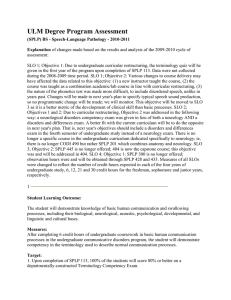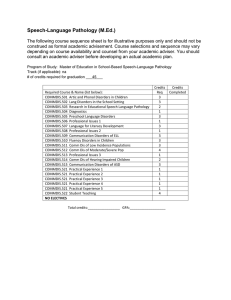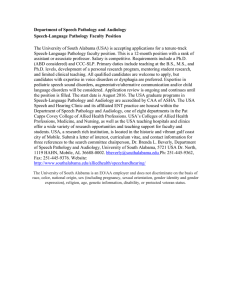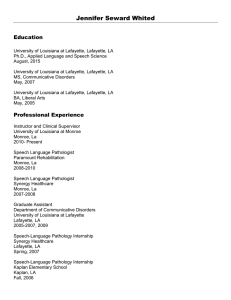ULM Degree Program Assessment
advertisement
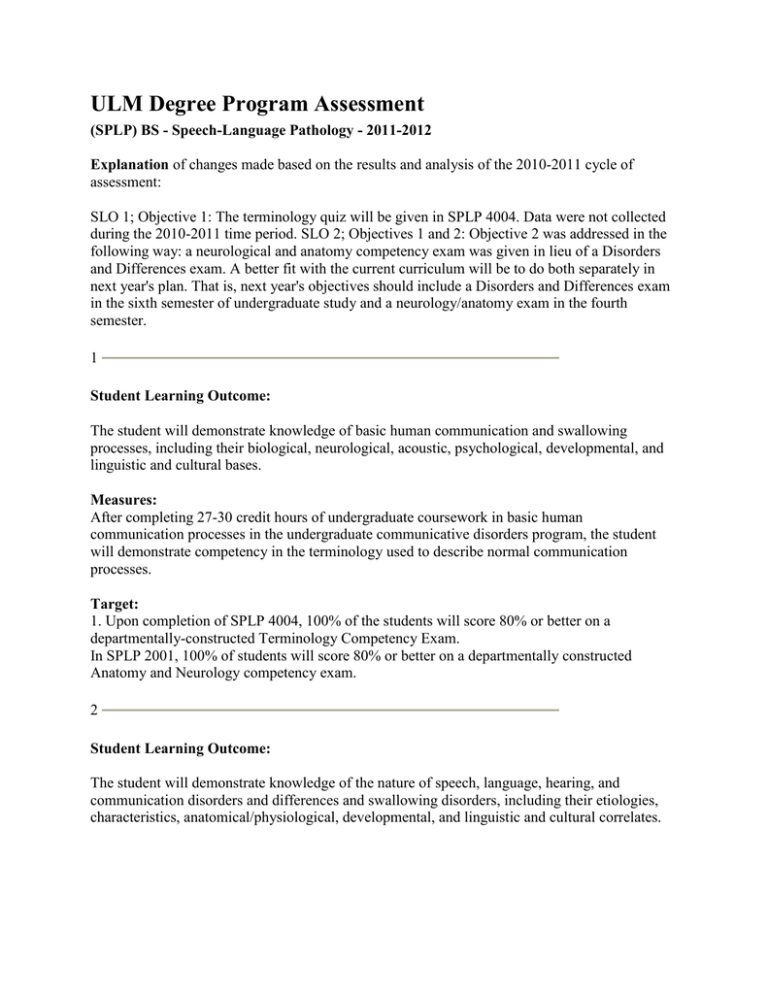
ULM Degree Program Assessment (SPLP) BS - Speech-Language Pathology - 2011-2012 Explanation of changes made based on the results and analysis of the 2010-2011 cycle of assessment: SLO 1; Objective 1: The terminology quiz will be given in SPLP 4004. Data were not collected during the 2010-2011 time period. SLO 2; Objectives 1 and 2: Objective 2 was addressed in the following way: a neurological and anatomy competency exam was given in lieu of a Disorders and Differences exam. A better fit with the current curriculum will be to do both separately in next year's plan. That is, next year's objectives should include a Disorders and Differences exam in the sixth semester of undergraduate study and a neurology/anatomy exam in the fourth semester. 1 Student Learning Outcome: The student will demonstrate knowledge of basic human communication and swallowing processes, including their biological, neurological, acoustic, psychological, developmental, and linguistic and cultural bases. Measures: After completing 27-30 credit hours of undergraduate coursework in basic human communication processes in the undergraduate communicative disorders program, the student will demonstrate competency in the terminology used to describe normal communication processes. Target: 1. Upon completion of SPLP 4004, 100% of the students will score 80% or better on a departmentally-constructed Terminology Competency Exam. In SPLP 2001, 100% of students will score 80% or better on a departmentally constructed Anatomy and Neurology competency exam. 2 Student Learning Outcome: The student will demonstrate knowledge of the nature of speech, language, hearing, and communication disorders and differences and swallowing disorders, including their etiologies, characteristics, anatomical/physiological, developmental, and linguistic and cultural correlates. Measures: After completing 12 credit hours of undergraduate coursework in disorders and differences of communication, the student will demonstrate knowledge of disordered aspects of communication, including language, articulation/phonology, hearing, and neurology. Target: 1. During the sixth semester of the undergraduate program, 100% of the students will score 80% or better on a departmentally constructed Disorders and Differences Competency Exam. 3 Student Learning Outcome: The student must possess knowledge of the principles and methods of prevention, assessment, and intervention for people with communication and swallowing disorders, including consideration of anatomical/physiological, developmental, and linguistic and cultural correlates of the disorders Measures: After completing 21 credit hours of undergraduate coursework the student will demonstrate knowledge of methods of prevention, assessment, and intervention for persons with communication and swallowing disorders, and their relationship to anatomical, developmental, linguistic and cultural correlates of the disorders. Target: 1. 100% of the students will score 80% or better on a departmentally constructed project, a case study required in SPLP 4004, applying the knowledge and skills acquired. 2. 100% of the students in SPLP 4004 will complete a Powerpoint presentation based on research of communication disorders and differences in an ethnic and/or social culture other than their own. 3. 100% of students who take Phonetics (SPLP 4001) will score 80% or better on a comprehensive evaluation of transcription of normal speech. 4 Student Learning Outcome: The student will successfully complete the undergraduate program making them eligible for admission into a graduate program in speech-language pathology or audiology. Measures: After completing the required courses in the undergraduate curriculum (minimum of 30 credit hours) the students will have the necessary background to successfully gain admittance to a graduate program in speech-language pathology or audiology. Target: 1. 100% of the students will obtain 25 clinical observation hours in SPLP 4028 and 4033. 2. After completing the undergraduate program in communicative disorders, 80% of those who apply to a graduate program in speech-language pathology or audiology will be accepted.
